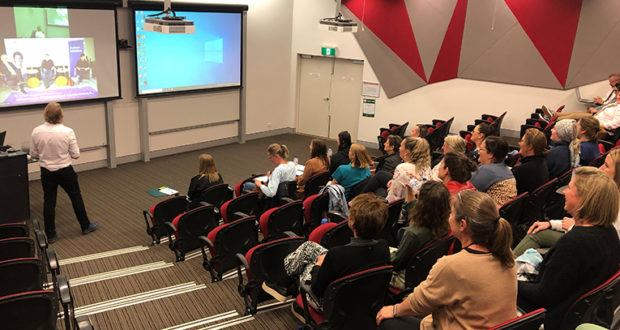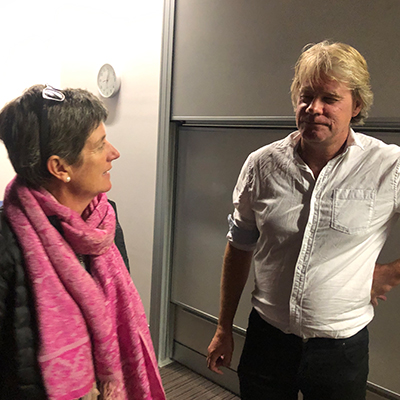He’s the author of Testing 1, 2,3: What Australian education can learn from Finland, and this month teacher, writer and tragic Midnight Oil fan Michael Lawrence joined other educators in Orange, NSW, to take teachers through a one-day session of a Finnish perspective to education.
The personal development session, which is the first of its type in Australia, was developed in conjunction with the Tampere University of Applied Sciences in Finland. The single-day suite of lessons was designed by staff from Tamepre’s Education Faculty and was pitched at Australian teachers.
In addition to learning during the session, participants received a free copy of the Finnish Teacher Digital Toolbox, containing sample lessons, a socio-constructive lesson building app, and a comprehensive outline of the Finnish education system's character and achievements.
Seven schools attended the PD sessions at Charles Sturt University’s Orange campus, and discussed, explored, and – at times – debated issues relating to the following:
- the failings of the Australian system and how the Finnish system looks at these issues
- video interviews put together specifically for Australian teachers with Finnish class teachers, subject teachers, education students and counsellors, with further discussion and suggestions about how the techniques and ideas described can make a difference in Australian schools immediately, and
- a video linkup with a panel from the Educational Sciences Faculty of Tampere University of Applied Sciences where participants could ask questions arising from the earlier sessions in the day, and others pertaining to their own teaching.
“The overall focus is on what lies behind Finland’s great success as an education system and the application of elements of it in Australia,” Lawrence says.
“For instance, some schools at the session had already made changes to their timetabling and had immediate success with increased student engagement and increased student and teacher satisfaction.
“After two decades at or close to the top of the international tables, introducing Finnish methods is evidence-based learning. The PD program will explain the Finnish success and the neuroscience behind it. Whether your school makes only minor changes or completely revises the program, your understanding of how and why will be transformed.”
One of the teachers who spoke to Education Review about the experience was Debbie Guisard, a K1 Teacher at Borenore Public School. She describes the school as small with three classes and only two teachers. The sole principal is also expected to teach.
Debbie covered the main points of the session, highlighting some of the key differences between the two education systems as well as teacher education training. As has been reported widely, Finnish teachers must hold Masters qualifications to teach.
To some, this might suggest overreach or asking a little too much. However, “the retention rates of teachers in Finland compared to Australia” is high, and their students are outperforming ours on the latest international data.
The high level of mental health and anxiety cases here was another critical point brought up, and the existence of stressful, high-stakes tests in Australia. This contrasts with the Finnish perspective “to just let the children play” and is reflected in the fact that Finnish students are seven when they commence schooling, compared with five in Australia.
Another key feature of a Finnish educational perspective is tapping into students’ “internal motivation to want to learn” – not offering great grades, rewards, and so on – to achieve great outcomes.
“The autonomy of teachers to teach the curriculum and outcomes in the way that best suits their class,” was another critical topic covered in the sessions, Debbie said, as well as ensuring every one-hour lesson included a ten-minute break for students to regroup. The different suite of pedagogical approaches available to teachers was well received.
The public-school teacher was impressed by the high level of “support available to teachers at each school (one school counsellor plus two psychologists, depending on the school size) to catch and support students as soon as a concern is raised by a teacher”.
She also found the “focus on social and emotional wellbeing” to be impressive, as well as “individualised programs for each student”. More than anything, “having happy students who want to be at school” is what every teacher ideally wants.
Debbie’s school has already made some inroads into the Finnish education system, with changes to class bell times implemented after all staff read, Let the Children Play: How More Play Will Save Our Schools and Help the Children Thrive by Pasi Sahlberg and William Doyle.
A Finnish perspective is also evident in the choices children can make to take responsibility for their own learning.
For instance, students in older grades determine “which spelling words in the unit they need to learn ... each child makes their own list rather than having a set class list,” Debbie says.
“It is not about copying their system and making another Finnish Education system in Australia.
“It is about adapting and adopting some of the strategies/ideas that are possible within the constraints of the Australian Education System.
“When really looking at our programs we were pleased to find we already have some of the attributes of the Finnish perspective in place in our current programs.”
Information on registering your school for the Finnish Perspective PD session can be found here.
Do you have an idea for a story?Email [email protected]
 Education Review The latest in education news
Education Review The latest in education news


I was lucky enough to attend ASEF Classnet 14 in Helsinki at the end of 2018, and I was impressed by what I saw at the Gymnasiet Larkan. I spent three days observing students in both formal and informal contexts and found myself intrigued by the student confidence, independence, engagement and sense of having a voice valued by teachers. The rapport between teachers and students was collegial rather than paternal. The teachers were respected and trusted to craft their pedagogical practice to suit their students and students engaged in a n umber of global projects in practical, hands on exchanges with schools in the Asia-Europe Foundation. The system I noted, was grass roots up rather than the imposition of top down autocratic curriculum and high stakes assessment. Students had projects and the school was open well beyond school hours, used as a gathering and learning hub for the community.
Since my initial ASEF Classnet conference in 2018, I have lead two projects and continue to build opportunities for global collaborations, something that is sorely lacking in so many Australian schools. Our excuse is that our curriculum doesn’t allow time and so such things are pushed into extra-curricular contexts. The Finnish model doesn’t appear to cram content, it allows for deep learning and exploration.
Most of all, I loved the appreciation of gender equity, wellness and mutual respect that was apparent in the relationships of staff, students and parents. They recognise the value of each and took time to appreciate it in an authentic way. I do think we have much to learn. Perhaps we could start by designing schools with greater flexibility in mind and curtail the imposition of more content so that students don’t feel disempowered. Perhaps we could leverage the student’s interest in particular subjects and negotiate and integrate subjects more meaningfully. Life isn’t lived in isolated disciplines. We draw upon all subjects as we negotiate life in a meaningful way. Instead of insisting all students do specific subjects, perhaps nurturing their natural talents and integrating the other subjects in relevant ways might be productive.
As a practicing educator of 33 years, I feel incredibly disheartened by the stress we place upon our students. The numbers of students needing special consideration because of anxiety disorders is on the rise. If we don’t change our paradigm, can we at least demonstrate the process of working through productive failure, so that they see us as equally fallible and where we model the ways that failure can be used as a tool for learning?
Creativity, collaboration and curiosity might be better served by taking some lessons from the Finnish experience.
All opinions are my own.
Juliette
Juliette,
Thanks for your observations. As an educator, I found that Finland was something of an educational nirvana; all the elements that inspire a teacher and student were present and the focus was always on enjoying learning rather than on grades.
I agree that we do have much to learn though at the moment; we have almost painted ourselves into a corner where many see it as almost impossible to turn around. Sadly, until we do so thousands of Australian students will turn their backs on education, believing that it is not for them.
In any other industry, ignoring world’s best practice will is a disaster, and this is the case in education. It’s just not obvious that it’s occurring as most of us (I was in this boat too) are not aware that we are doing it.